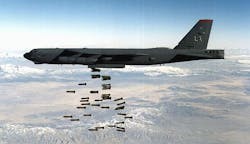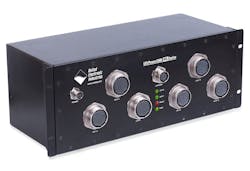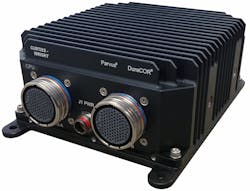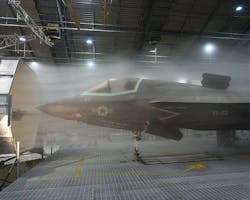Data acquisition hardware meet test & measurement demands
Modern DAQ hardware speeds aerospace system development, test and verification, and certification.
By Courtney E. Howard
The global data acquisition (DAQ) hardware market will witness surging growth, predict industry analysts at Grand View Research in San Francisco, Calif. DAQ hardware is widely used for research and analysis, design validation and verification, system certification, manufacturing and quality test, diagnostics and repair, asset condition monitoring, and PC-based control and automation, they describe.
Several trends are contributing to a continued uptick in DAQ adoption, especially among aerospace professionals. According to Grand View Research analysts, they include:
- increasing data monitoring requirements worldwide;
- increasing research analysis and design activities, such as characterizing new product designs;
- design validation and testing, including verifying product lifecycle, establishing evidence, testing for accuracy and reliability, and ensuing conformance to industry standards;
- manufacturing and quality testing, including mechanical, electrical, and environmental tests;
- diagnostics and repair systems for identifying root cause;
- asset conditioning and monitoring, such as long-term condition monitoring of equipment like compressors and turbines to detect problems and prevent failures;
- condition monitoring to optimize performance, prevent outages, and reduce repair costs; and
- PC-based control systems to add automation and reduce human interaction.
New and old, military and commercial
The demand for data is always growing, affirms Bob Judd, director of marketing at United Electronic Industries (UEI) in Walpole, Mass. Judd and his colleagues at UEI are seeing considerable growth in DAQ for aircraft and systems testing.
“The DAQ market is definitely expanding as new platforms are designed and coming on line, and as the older legacy systems and procedures are phased out in favor of flexible, rugged COTS platforms,” Goethert says.
UEI data acquisition and control systems are being used in a number of different military, commercial, and aerospace applications. “Some of the larger aircraft manufacturers are using DAQ for real-time health monitoring of critical aircraft components, new aircraft structural flight-testing, as well as new aircraft system integration laboratories (SIL) labs,” Goethert describes. Many aerospace companies are adopting DAQ products for launch control, avionics logging and translation, and rocket/capsule ground applications, he says.
“We see more testing done on older aircraft and aircraft systems, in retrofitting and testing older platforms” Judd says. This is particularly true of military aircraft, “as operators try to confirm they can safely extend the life of aircraft beyond what may have been original design goals.”
Budgetary constraints and delays in the fielding of new military aircraft have driven organizations to extend the useful life of legacy platforms; to reduce the risks associated with doing so, engineers and maintenance technicians have relied – and continue to rely – on data acquisition tools. At the same time, new aerospace vehicle and system designs can require considerable test and measurement, to meet verification, validation, and certification requirements, for example.
“We see increases in testing of newer aircraft and aircraft systems, as the manufacturers work very diligently to confirm the aircraft computer-aided drafting (CAD) models have accurately predicted the actual aircraft’s performance in flight,” Judd affirms. Also, “with the increasing costs of actual aircraft flight time, we are seeing a great deal of DAQ use by many flight simulator manufacturers.”
Two of the hottest growth sectors in the aerospace community are unmanned aircraft systems (UAS) and commercial space, including satellites, hosted payloads, spacecraft, and launch platforms such as rockets. The unmanned aircraft market is certainly growing, and that “explosive growth is driving demand for small, rugged DAQ platform,” Judd says. “We are also seeing a great deal of interest from the growing ranks of commercial space companies. While there where only a couple private launch companies 5 years ago, now there has been a tremendous amount of entrants into the market and each has its own unique spacecraft -- but all have a great need for data acquisition.”
DAQ applications may vary widely, but a growing majority of system requirements are the same.
Common criteria
Aerospace and defense customers are looking for smaller, lighter, more rugged, deployable commercial off-the-shelf (COTS) systems to use in the field, in integration and test labs,” says Erik Goethert, director of sales at UEI.
“Solutions need to be smaller, lighter, more rugged -- and flexible to meet the ever changing and expanding DAQ and control environments,” explains Goethert, who is seeing greater use in both field test and simulated environments. Systems need to be designed to acquire, track, and manage various signals in the lab or in the field. Whether you are collecting signal data from braking systems or simulating a munitions test, DAQ solutions need to be able to handle the breadth of input/output (I/O) required for a variety of avionics environments."
Some of the requirements Goethert describes as “easier to miss” include:
- Product life cycle: Is this hardware supportable and maintainable for 10, 20, or 30 years? It’s important to know if you have a system and a vendor that is in it for the long haul and building systems for the future.
- COTS availability: both for order lead time and for emergency replacements
- Vendor support: Take advantage of your vendor’s support team before you buy; call or e-mail and ask questions as though you were already a customer. Some vendors in the industry are very responsive, while others may consider a 48-hour response to an emergency support request is acceptable, he says.
- System- and channel-level diagnostic and troubleshooting while deployed in the field: Ask whether the system has the ability to report back the health of your hardware? “If not, you are missing a key component in your system for accuracy and maintainability,” Goethert explains.
COTS
DAQ users share two important, and even critical, concerns: the ability to use COTS hardware and long-term availability, Judd says.
“The military is pushing very hard for their test systems to move to COTS hardware due to the need for longevity and maintainability,” Goethert adds. “Many, if not most, of the commercial space/aircraft manufactures are following suit.”
“Customers are demanding the COTS hardware be flexible for many different use cases – from in-field test and control, to factory automated test equipment (ATE), to hardware and software integration test labs,” Goethert says. “Having islands of equipment for a single task leads to additional cost, technical, and obsolescence risks.”
Users “have also been bitten by consumer PC bus systems, such as PCI, PXI, cPCI, etc., changing and going obsolete, so they are demanding Ethernet or even fiber Ethernet connectivity to protect their investments,” Goethert explains.
Customers indicate that long-term availability is key, Judd says, so UEI launched a program that guarantees “a minimum of 10-year availability on DAQ and control systems.”
Flight test
Demand for data is constantly growing, recognizes Dave Buckley, product manager, flight test instrumentation at Curtiss-Wright Controls Avionics & Electronics in Dublin, Ireland. “In every flight test campaign, we see in an increase in the amount of data acquired and recorded. To some extent, the availability of new, higher-speed data acquisition networks is creating the demand. New equipment allows the flight test engineer to capture more measurements than before; these measurements can be used to better understand the behavior of the test article during flight.
“Data acquisition systems in the flight test domain have moved from technologies such as IRIG 106 chapter 4 PCM to Ethernet, which has enabled the large growth in acquired data,” Buckley says. “Data acquisition networks with gigabit Ethernet switches as the backbone are now common. Ethernet has also become the de-facto standard for connecting up data acquisition networks.”
Ruggedness has always been an absolute requirement in the flight test domain, Buckley mentions. As the number of measurements increase, however, it is important that the size and weight of the system does not grow proportionally, he adds. “Therefore, there is a drive to reduce the size and weight of the data acquisition hardware.”
“There is also a move toward open standards to allow interoperability of equipment from many vendors,” Buckley says. DAQ equipment also can be used in low Earth orbit (LEO), where radiation tolerance is a key requirement.
For airborne data acquisition, reliability and modularity are two of the most important considerations. Re-running test points due to lost data is very expensive and can jeopardize timely completion of the flight test campaign. For this reason, it is important that the hardware is extremely reliable and will continually acquire data even after power interruptions on the flight test network.
Modularity allows the flight test engineer to build any configuration with off-the-shelf data acquisition chassis and modules, Buckley describes. “Curtiss-Wright’s approach is based around having a large catalogue of interfaces modules and a flexible approach to developing new modules for aircraft specific interfaces. This means the flight test engineer is only ever one module away from any configuration.”
Diagnostic data
Aerospace engineering managers stress the importance of fast and accurate acquisition and exploitation of diagnostics data. Measurements gleaned from data acquisition hardware and software systems can help enhance flight safety, improve operational efficiency, speed time to market, and reduce maintenance costs, among other benefits. Many airlines are opting to outfit entire fleets of aircraft with DAQ systems for health monitoring or condition management purposes.
"Aircraft condition management systems (ACMS), whether integrated or federated, continue to be the source of valuable data," says William Cecil, director of business development at Teledyne Controls in El Segundo, Calif.
Pressure exists to collect more and more data, about the overall aircraft and individual aircraft systems, including landing systems and avionics. Avionics diagnostics tools are commonly used for: engine exceedance reporting, airframe structural monitoring, engine health monitoring, auxiliary power unit monitoring, actuators monitoring, environmental control system monitoring, fuel consumption monitoring, landing gear/brakes monitoring, sensor failure detection, and onboard flight operations quality assurance event detection.
Data volumes are increasing in size, reaching between 5 megabytes and 10 megabytes per flight hour, Cecil says. "The latest engines are capable of generating vast volumes of data," which is driving the need for high-capacity, robust data acquisition, processing, transmission, and storage solutions.
Automated flight data analysis tools improve aircraft safety and maintenance, affirms Fabrice Ferrand, chief engineer at Sagem Defense Securite in Paris, France. "The number of departures has been steadily increasing, yet the aviation accident rate has been significantly reduced," he says.
Gulfstream's use of and the comprehensive data gleaned from modern avionics diagnostics software and hardware tools. In fact, Gulfstream estimates that it has collected a minimum of 30,000 hours of data to serve as a baseline for the Gulfstream G650 business jet. The company is gaining proven benefits from being "proactive, rather than reactive" and "data mining" the aircraft, says Robby O'Dell, program manager at Gulfstream Aerospace Corp. in Savannah, Ga.
Rugged requirements
When it comes to flight test applications and structural health and usage monitoring for crash recording, "they all want rugged," explains Stephen Willis, product marketing specialist, Curtiss-Wright Avionics & Electronics in Dublin, Ireland. "Crash recorders obviously have the most extreme ruggedness. Other recorder applications for flight test on commercial aircraft have to be rugged or else they won't survive the application. If you go even further, data recorders are used in space applications.
"We've had [data recording] boxes go to and from the International Space Station (ISS), for example, and others being used in experimental tests coming back into orbit” with data that is, essentially, the output of the mission. Ruggedness and seeing that the data survives are critically important, he concludes.
Given the value of data, much of which is irreplaceable, aerospace engineers and systems integrators are opting for rugged data storage devices that interface with data acquisition devices. Product engineers at Astronics Ballard Technology in Everett, Wash., designed a rugged, portable storage device to meet the unique needs of military and aerospace applications, including maintenance and vehicle health monitoring.
"We see a trend toward recording more and more performance data, especially on the commercial side for health and usage monitoring systems (HUMS), given all the advantages that offers," says Bill Schuh, vice president of sales at Astronics Ballard Technology. The Rugged Toe Drive USB mass storage module is a rugged medium for maintenance and health monitoring systems, and recording performance data for fixed-wing and rotor-wing aircraft. The drive is resistant to high vibration and shock, as well as can be removed, switched out, or the data transferred through an existing wireless link, Schuh adds.
Cutting-edge DAQ
Technology suppliers continue to invest in developing data acquisition tools to meet current and future aerospace user and program requirements, as well as novel applications.
UEI engineers have developed a unique solution for a military munitions replacement test set that will test aircraft armament equipment in a go/no go fashion, Goethert describes. “The equipment being tested includes missile and rocket launchers, smart and legacy bomb racks, and pylons. These items have increasing electronic content and will continue to evolve to more signal I/O intensive and sophisticated testing requirements.” UEI’s system was designed to be smaller, lighter, more rugged, and more powerful than current legacy systems, and to provide greater data accuracy, ease of use, and overall time and cost savings, he adds.
New data acquisition solutions are also being engineered with customization and flexibility in mind.
"UEI’s military line of chassis utilizes COTS hardware with an interface board that is customizable to the specific connector (38999 or otherwise) and pinout; since it is based on COTS hardware, any and all interfaces are supported,” Goethert says.
Curtiss-Wright’s data acquisition units (DAU) are based on the “any module, any chassis, in any combination” concept, Buckley says. User-selected modules or chassis can be added to enable highly configurable and customized systems to be built using COTS products, he says.
Aerospace professionals continue to request cost-effective, rugged, and flexible data acquisition solutions to meet the demands of different engineering department goals, as well as for a wide variety of complex and demanding military and aerospace applications, Goethert says. Whether it is ground launch support for the private rocket industry or in-flight acquisition and control, he adds, COTS hardware is helping to solve many of today’s modern engineering challenges.





